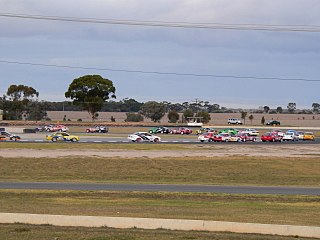
Light Regional Council is a local government area north of Adelaide in South Australia. It is based in the town of Kapunda, and includes the towns of Freeling, Greenock, Hansborough, Hewett, Roseworthy and Wasleys.

Two Wells is a town approximately 40 kilometres north of the Adelaide city centre in South Australia adjacent to Port Wakefield Road and passed by the Adelaide-Port Augusta railway line. The first settlers in the area used two aboriginal wells in the area as a freshwater source. At the 2016 census, Two Wells had a population of 1926.

The Adelaide Plains Council is a local government area in South Australia. It consists of a largely rural region along the Gulf St Vincent, covering a total area of approximately 926 km2. The council seat lies at Mallala, but it also maintains a service centre at Two Wells.

Port Gawler is a locality and former port on Gulf St Vincent on the central Adelaide Plains in South Australia. Port Gawler is located 43 kilometres (27 mi) north west of Adelaide in the Adelaide Plains Council local government area at the mouth of the Gawler River.

Thomas Cowan served one term as a member of the South Australian House of Assembly for the Electoral district of Yatala.
Adelaide Plains wine region is a wine region located in South Australia immediately north of the capital city of Adelaide. The region received appellation as an Australian Geographical Indication in 2002 and as of 2014, it is represented by 11 wineries. It is part of the Mount Lofty Ranges zone.

The 2015 Pinery bushfire was a bushfire that burned from 25 November to 2 December 2015, and primarily affected the Lower Mid North and west Barossa Valley regions immediately north of Gawler in the Australian state of South Australia. At least 86,000 hectares of scrub and farmland in the council areas of Light, Wakefield, Clare and Gilbert Valleys, and Mallala were burned during its duration.

The Hundred of Port Gawler is a cadastral unit of hundred located on the central Adelaide Plains in South Australia and bounded on the south by the Gawler River. It is centred on the town of Two Wells with the locality of Port Gawler at the south western corner of its boundary. It is one of the eight hundreds of the County of Gawler. It was named in 1851 by Governor Henry Young either directly or indirectly after the former Governor George Gawler.

The Hundred of Inkerman is a cadastral unit of hundred located on the northern Adelaide Plains in South Australia and bounded on the north by the Wakefield River. It is one of the eight hundreds of the County of Gawler. It was named in 1856 by Governor Richard MacDonnell after the Crimean War Battle of Inkerman.

The District Council of Light was a local government area in South Australia from 1977 to 1996, seated at Freeling.

The District Council of Pirie was a local government area in South Australia from 1892 to 1996. It surrounded, but did not include, the city of Port Pirie, which had its own municipal government as the City of Port Pirie.

The District Council of Mobilong was a local government area in South Australia from 1884 to 1977.

The Hundred of Dalkey is a cadastral unit of hundred located on the northern Adelaide Plains in South Australia immediately south of the Wakefield River. It is one of the eight hundreds of the County of Gawler. It was named in 1856 by Governor Richard Graves MacDonnell for his hometown Dalkey, a seaside resort in Ireland.

The District Council of Balaklava was a local government area seated at Balaklava in South Australia from 1877 to 1983.

The District Council of Munno Mara West was a local government area of South Australia on the central Adelaide Plains from 1854 to 1933.

The District Council of Dublin was a local government area in South Australia from 1873 to 1935, seated at Dublin.

The District Council of Grace was a local government area in South Australia from 1874 to 1935, seated at Mallala.

The Hundred of Mudla Wirra is a cadastral unit of hundred located on the northern Adelaide Plains of South Australia. The hundred was proclaimed in 1847 in the County of Gawler and named by Governor Frederick Robe. The hundred is bounded on the north by the Light River and on the south by the Gawler River.

The Hundred of Grace is a cadastral unit of hundred located on the northern Adelaide Plains of South Australia spanning the township of Mallala and the Grace Plains. The hundred was proclaimed in 1856 in the County of Gawler and named by Governor Richard Graves MacDonnell after Grace Montgomery Farrell, wife of James Farrell, Dean of Adelaide. The hundred spans a significant portion of the lower Light River, which flows from north east to south west through the area.










